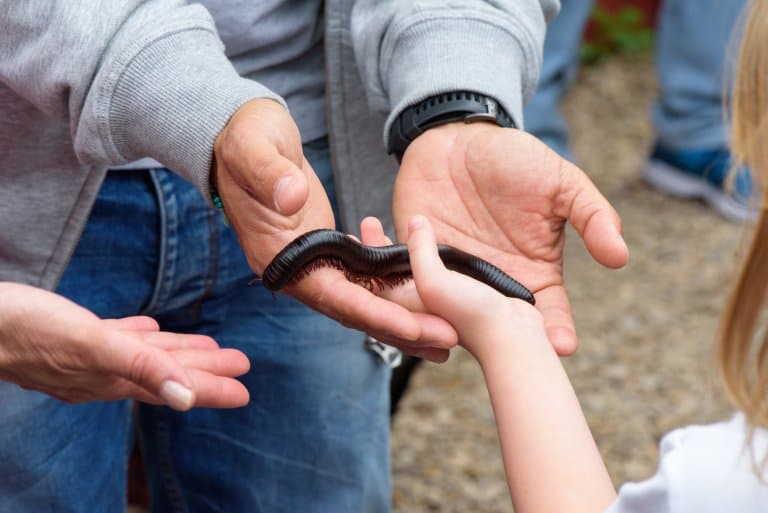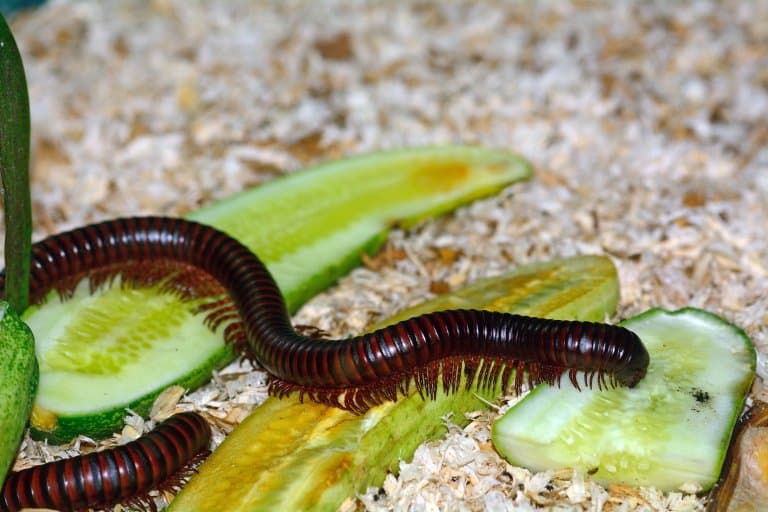Giant African Millipede Profile
In the Southernmost part of the African continent, long, winding trains traverse the countryside, these trains share a name with a much smaller, yet far more significant and widespread creature that roams the forest floor in much of Sub-Saharan Africa.
This is the giant African millipede, an armoured behemoth that’s one of the most important animals on the forest floor.

Giant African Millipede Facts Overview
| Habitat: | Lowland forest and woody undergrowth |
| Location: | East and South Africa |
| Lifespan: | Up to around 10 years |
| Size: | Up to 34cm (13.5in) long |
| Weight: | Possibly up to 275g (9.6 0z) |
| Color: | Black or red |
| Diet: | Omnivorous, mostly plant matter and detritus |
| Predators: | Birds and some small mammals |
| Top Speed: | Slow |
| No. of Species: |
1 |
| Conservation Status: |
Least Concern |
The giant African millipede is widespread in East Africa, where they mostly live on the forest floor, but do also live in coastal regions near woodland. Like all millipedes, they are nocturnal and spend their time on the rainforest floor eating decaying plant material.
Millipedes are named after their copious amounts of legs; legs that work in two pairs attached to each segment. They’re well-protected with armour and chemical defences and can even withstand some of the more ferocious of forest arthropod predators.
Because of their penchant for vegetables, their slow movement and their docile nature, giant African millipedes make it popular and easy to look after pets for collectors.
Interesting Giant African Millipede Facts
1. They are the largest species of millipede
There are thought to be over 10,000 different species of millipede and the giant African millipede is the largest.
They can grow up to 34cm (13.5in) in length and around 67 mm (2.6 inches) in circumference.

2. They have a lot of legs
The word millipede does make it sound like they should have a million legs, although the Latin root for the word million actually means one thousand.
Until recently, this would be irrelevant anyway, because all known millipedes had somewhere around 250 to 750 legs. Recently, however, the first true millipede was found. A subterranean species, unsurprisingly discovered in Australia was found to have 1,306 legs.
Giant African millipedes aren’t as well-equipped. Individuals of Archispirostreptus gigas typically have around 256 legs, depending on how old they are, and how successful their last moult was.
3. They poo when you pick them up
A. gigas are gentle giants. They’re slow-moving, and they munch on decaying vegetation, usually in the damp forest undergrowth. They don’t pose much of a threat to anything and are commonly found minding their own business.
This would make them a prime target for an opportunistic predator, but this giant millipede has some excellent defences. First of all, when threatened, it curls up into a tight ball, protecting its softer belly with its armoured exoskeleton.
If that doesn’t work, it will leave a nasty deposit from their butt to dissuade you further.
Then, if you’re dumb enough to try and eat it anyway, the millipede has toxic secretions from pores along the side of its body that could make you very sick.
All in all, this lumbering behemoth is well protected against almost all predators.
4. They’re invulnerable to driver ants
As you may know from our driver ants profile when millions of powerful walking jaws raid the forest floor, very little is safe.
Driver ants take on pretty much anything alive, but the secretions released by these millipedes make them distasteful, and this allows them to weather the storm unpunished.
A combination of tightly coiling into a ball and covering yourself in toxic excrement appears to be a good defence against some of the most formidable predators in the jungle, so keep that in mind if you ever find yourself in that position.
5. They make great pets
Despite all this, giant millipedes can be handled with ease. As long as you are gentle, they get used to being handled very quickly, and in combination with their tolerance to a range of humidity and temperatures, this makes them a very good starter pet for exotic animal enthusiasts.
They can also be kept together with others of the same species without trouble. 1

6. They play a significant role in the ecosystem
You might think that an animal like this, munching away at dead leaves and staying out of trouble, wouldn’t really contribute much to the world as a whole.
On the contrary!
Millipeds are one of the most significant animals in the forest and are ranked (by some very strange people who rank these things) as the most important detritivores (organisms that feed on decaying matter) in the forest.
If you know how important earthworms are to recycling organic matter within the ecosystem, then you’ll have an idea of the role of millipedes too.
Along with termites, worms and dung beetles, millipedes are part of a team of forest cleaners who take used material and turn it back into nutrients to be used again.
7. But they do fart a lot
One of the side effects of eating mulch is that it can give you gas.
Unfortunately, A. gigas has a gut that releases methane as a by-product of all its digestive processes.
Methane is one of the most potent of all the greenhouse gases, so understanding how it’s produced in this way, and whether there’s an option of offering antacids to reduce it, might be a useful component in slowing the effects of climate change. 2

8. They hang out with some dangerous mites
Many animals carry mites. Aside from the smallest mite, it may even be said that all animals carry them. In most cases, the mites are hitching a ride at best, and gradually consuming their host at worst.
Usually, they don’t offer much in return for their presence, but in the giant African millipede, its mites are thought to help keep it clean and remove little bits of food and dirt that it can’t reach with its tiny little feet. 3
9. Ride the Millipede
Mites aren’t the only creature to infest millipedes.
Xhosa is one of the Nguni languages of Southern Africa, and one of the most beautiful spoken languages there is due to its click consonants and tonal inflections.
In this language, the millipede is known as shongololo, which basically means “one who rolls up”.
When trains entered the continent, their resemblance to these extended arthropods did not go unnoticed. Today, you can ride the millipede, and take the Shongololo Express across multiple Southern African countries over nearly three weeks.
10. They are not to be confused with a centipede
The key differences between millipedes and centipedes are that –
- Millipedes have four legs per body segment; centipedes have two
- Millipedes legs are positioned under their body, while centipedes are to the side.
- Millipedes are omnivores, while centipedes are carnivores.
- Millipedes do not have venom or bite, while centipedes have fangs with venom.
- While ‘mille’ in millipede means a thousand, ‘centi’ in centipede means hundred. Pede means ‘feet’ for both, referring to their number of legs.
While there’s plenty of key differences, they also have enough in common to make them cousins in the animal kingdom.
Giant African Millipede Fact-File Summary
Scientific Classification
| Kingdom: | Animalia |
| Phylum: | Arthropoda |
| Class: | Diplopoda |
| Order: | Spirostreptida |
| Family: | Spirostreptidae |
| Genus: | Archispirostreptus |
| Species Name: |
Archispirostreptus Gigas |
Fact Sources & References
- “African Giant Black Millipedes“, Exotic-Pets.co.uk.
- Horváthová T (2021), “Methanogenesis in the Digestive Tracts of the Tropical Millipedes Archispirostreptus gigas (Diplopoda, Spirostreptidae) and Epibolus pulchripes (Diplopoda, Pachybolidae)“, Applied and Environmental Microbiology.
- C. Crawford, K. Bercovitz, M. Warburg (1987), “Regional environments, life-history patterns, and habitat use of spirostreptid millipedes in arid regions“, Zoological Journal of the Linnean Society.
